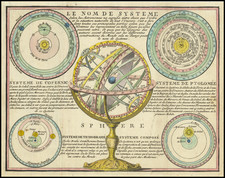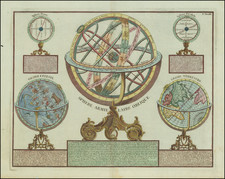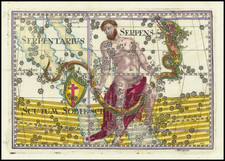Planisphaerium Caeleste by Georg Christoph Eimmart is a captivating double-hemisphere celestial map from the early 18th century. Its details drawn from the scientific models of the era's greatest astronomers and its depiction of the heavens offer a striking visual record of Renaissance astronomical thought.
This fine celestial map from 1720 hails from an era of great strides in the scientific understanding of the cosmos. Its twin hemispheres are surrounded by six circular diagrams that illuminate a variety of astronomical phenomena and theories. These include the Tychonic and Ptolemaic planetary systems, the relationship between the moon and the tides, the annual and monthly illumination of the earth and moon by the sun, and the Copernican planetary system.
The map also draws upon the work of Johannes Hevelius and his star atlas, Firmamentum Sociescianum sive Uranographia (1687), along with insights from Sir Edmund Halley. These influences serve to enrich the map's representation of constellations, integrating key astronomical knowledge from multiple sources into one cohesive visual portrayal.
Imbued with the imprint of its creator, German draftsman and engraver Georg Christoph Eimmart, the map stands as a testament to his skilled craftsmanship. Born in Ratisbon in 1638 and active until his death in 1705, Eimmart's contributions to the field of celestial cartography are evident in this intricate work.
Planisphaerium Caeleste presents an absorbing union of art and science, encapsulating the celestial understanding of its time. Eimmart's map is not only an aesthetically pleasing artifact but also a valuable historical document that captures the astronomical knowledge and curiosity of the Renaissance era.









![(Early Philadelphia Architectural Drawings) Plan of the ceiling of St. Andrews Church [with two additional drawings on another sheet]](https://storage.googleapis.com/raremaps/img/small/90443.jpg)




